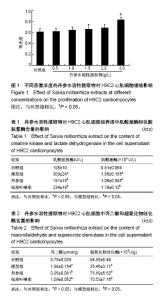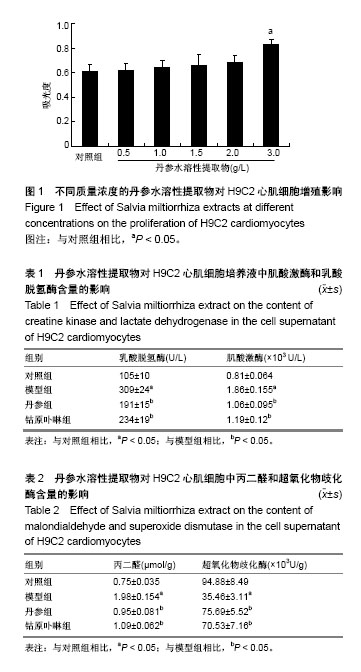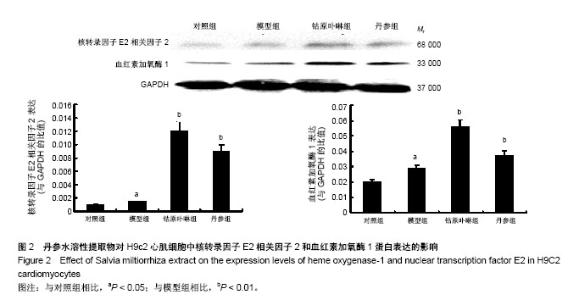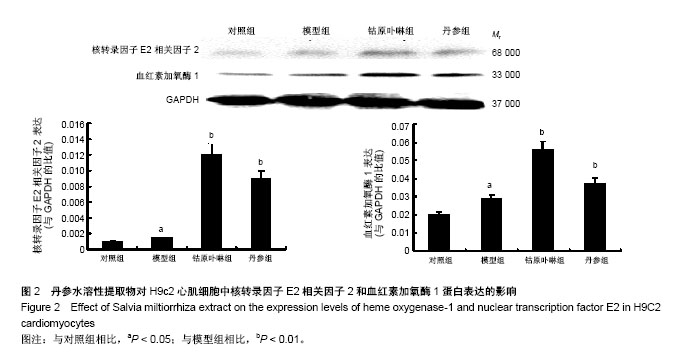| [1] Kalogeris T, Baines CP, Krenz M, et al. Cell biology of ischemia/reperfusion injury. Int Rev Cell Mol Biol. 2012;298: 229-317. [2] 李俊平,郭丽丽,陈中,等.丹蒌片对大鼠心肌缺血再灌注损伤的保护作用及机制[J].中国实验方剂学杂志,2017,23(1):95-100.[3] 汤世民,吴咏梅,周雨亭,等.丹参酮ⅡA 对心肌缺血再灌注损伤大鼠氧化应激的保护作用[J].中国医药导报,2017,14(4):8-11.[4] Windecker S, Bax JJ, Myat A, et al. Future treatment strategies in ST-segment elevation myocardial infarction. Lancet. 2013;382(9892):644-657. [5] 王挺,杨怡,田玥,等.视神经萎缩症蛋白1通过抑制氧化应激减少高糖高脂诱导的心肌细胞凋亡[J].第三军医大学学报,2017, 39(2):151-156.[6] Xu H, Yao Y, Su Z, et al. Endogenous HMGB1 contributes to ischemia-reperfusion-induced myocardial apoptosis by potentiating the effect of TNF-α/JNK. Am J Physiol Heart Circ Physiol. 2011;300(3):H913-921. [7] Loboda A, Damulewicz M, Pyza E, et al. Role of Nrf2/HO-1 system in development, oxidative stress response and diseases: an evolutionarily conserved mechanism. Cell Mol Life Sci. 2016;73(17):3221-3247.[8] Dulak J, Deshane J, Jozkowicz A, et al. Heme oxygenase-1 and carbon monoxide in vascular pathobiology: focus on angiogenesis. Circulation. 2008;117(2):231-241. [9] Lakkisto P, Siren JM, Kytö V, et al. Heme oxygenase-1 induction protects the heart and modulates cellular and extracellular remodelling after myocardial infarction in rats. Exp Biol Med (Maywood). 2011;236(12):1437-1448. [10] Shan Y, Lambrecht RW, Donohue SE, et al. Role of Bach1 and Nrf2 in up-regulation of the heme oxygenase-1 gene by cobalt protoporphyrin. FASEB J. 2006;20(14):2651-2653. [11] 朱晓洁,梁飞,王秀宏,等.钴原卟啉对H9c2心肌细胞缺氧/复氧损伤的保护作用[J].中国药理学通报,2009,25(3):352-356.[12] 姜雪,史磊.丹参活性成分及药理作用研究进展[J].药学研究,2016,36(3):166-168.[13] 巴翠晶,李得鑫,段雪磊,等.丹参的药理研究进展[J].中兽医学杂志,2016(1):65-67.[14] 张代富,阮长武,刘中民,等.丹参对大鼠急性心肌缺血再灌注时心肌细胞凋亡及凋亡相关基因表达的影响[J].上海医学,2003,26(9):669-670.[15] 胡流芳,王迎,任汝静,等.Keap1-Nrf2/ARE信号通路的抗氧化应激作用及其调控机制[J].国际药学研究杂志,2016,43(1): 146-152.[16] Kaspar JW, Niture SK, Jaiswal AK. Nrf2:INrf2 (Keap1) signaling in oxidative stress. Free Radic Biol Med. 2009; 47(9):1304-1309. [17] Nguyen T, Nioi P, Pickett CB. The Nrf2-antioxidant response element signaling pathway and its activation by oxidative stress. J Biol Chem. 2009;284(20):13291-13295. [18] 王德明.丹参素提取工艺研究[J].生物化工,2017,3(1):10-12,16.[19] Jun HO, Kim DH, Lee SW, et al. Clusterin protects H9c2 cardiomyocytes from oxidative stress-induced apoptosis via Akt/GSK-3β signaling pathway. Exp Mol Med. 2011;43(1): 53-61.[20] Taguchi K, Motohashi H, Yamamoto M. Molecular mechanisms of the Keap1–Nrf2 pathway in stress response and cancer evolution. Genes Cells. 2011;16(2):123-140.[21] 谷仕艳,陈虹宇,张遵真.微小RNA 与氧化应激相互调控在疾病发生发展中的研究进展[J].现代预防医学,2017,44(2):306-308,374.[22] 赵然尊,秦继超,龙仙萍,等.核因子相关因子2参与间充质干细胞调节大鼠梗死心肌氧化应激作用[J].上海医学,2013,36(10): 876-880.[23] Keum YS, Yu S, Chang PP, et al. Mechanism of action of sulforaphane: inhibition of p38 mitogen-activated protein kinase isoforms contributing to the induction of antioxidant response element-mediated heme oxygenase-1 in human hepatoma HepG2 cells. Cancer Res. 2006;66(17):8804-8813.[24] Rubiolo JA, Mithieux G, Vega FV. Resveratrol protects primary rat hepatocytes against oxidative stress damage: activation of the Nrf2 transcription factor and augmented activities of antioxidant enzymes. Eur J Pharmacol. 2008; 591(1-3):66-72. |



